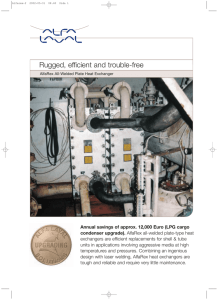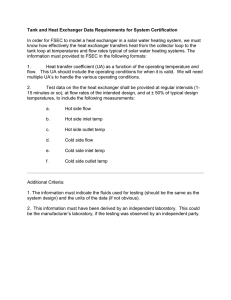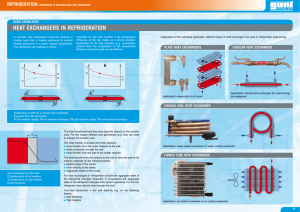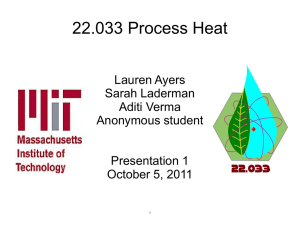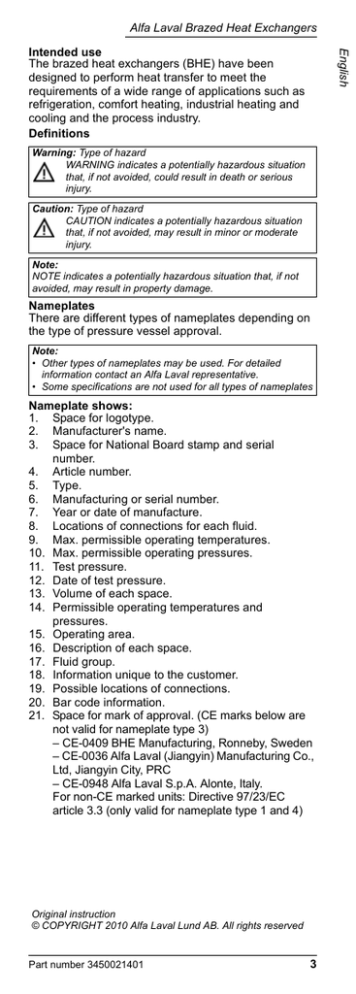
Alfa Laval Brazed Heat Exchangers
English
Intended use
The brazed heat exchangers (BHE) have been
designed to perform heat transfer to meet the
requirements of a wide range of applications such as
refrigeration, comfort heating, industrial heating and
cooling and the process industry.
Definitions
Warning: Type of hazard
WARNING indicates a potentially hazardous situation
that, if not avoided, could result in death or serious
injury.
Caution: Type of hazard
CAUTION indicates a potentially hazardous situation
that, if not avoided, may result in minor or moderate
injury.
Note:
NOTE indicates a potentially hazardous situation that, if not
avoided, may result in property damage.
Nameplates
There are different types of nameplates depending on
the type of pressure vessel approval.
Note:
• Other types of nameplates may be used. For detailed
information contact an Alfa Laval representative.
• Some specifications are not used for all types of nameplates
Nameplate shows:
1. Space for logotype.
2. Manufacturer's name.
3. Space for National Board stamp and serial
number.
4. Article number.
5. Type.
6. Manufacturing or serial number.
7. Year or date of manufacture.
8. Locations of connections for each fluid.
9. Max. permissible operating temperatures.
10. Max. permissible operating pressures.
11. Test pressure.
12. Date of test pressure.
13. Volume of each space.
14. Permissible operating temperatures and
pressures.
15. Operating area.
16. Description of each space.
17. Fluid group.
18. Information unique to the customer.
19. Possible locations of connections.
20. Bar code information.
21. Space for mark of approval. (CE marks below are
not valid for nameplate type 3)
– CE-0409 BHE Manufacturing, Ronneby, Sweden
– CE-0036 Alfa Laval (Jiangyin) Manufacturing Co.,
Ltd, Jiangyin City, PRC
– CE-0948 Alfa Laval S.p.A. Alonte, Italy.
For non-CE marked units: Directive 97/23/EC
article 3.3 (only valid for nameplate type 1 and 4)
Original instruction
© COPYRIGHT 2010 Alfa Laval Lund AB. All rights reserved
Part number 3450021401
3
English
Alfa Laval Brazed Heat Exchangers
Requirements
Warning: The heat exchanger must be installed and
operated in such a manner that no risk of injury to
personnel and damage to property will be incurred.
Note: Unless otherwise specified, product data for normal
refrigerants, i.e. HFC and HCFC, are applicable to refrigeration
applications. Before the heat exchanger is used for flammable,
toxic or dangerous liquids (e.g. hydrocarbons) the relevant
safety rules for handling such liquids must be used. For further
information, please refer to the Internet site of the supplier.
Installation
The installation must be provided with equipment that
protects the heat exchanger against pressures and
temperatures outside the approved minimum and
maximum values shown on the nameplate.
Caution: To avoid hand injuries from sharp edges,
protective gloves should always be worn when
handling the brazed heat exchangers.
For best possible heat transfer performance, the heat
exchanger should be connected so that the media flow
through the heat exchanger in opposite directions (in
counter-flow).
Note: Before connecting any piping, make sure all foreign
objects have been flushed out of the system.
Caution: Take into account the risk of fire during the
installation work, i.e. bear in mind the distance to
flammable substances.
Caution: Never lift by the connections. Straps should
be used when lifting. Place the straps according to
figure 1.
Note: In evaporator applications and in applications in which a
phase change of the media occurs, the heat exchanger must
be installed vertically with a straight pipe (at least 150-200 mm
in length) between the expansion valve and refrigerant inlet.
Mounting
In a rigid pipe system, small heat exchangers
(weighting 1–6 kg) can be suspended directly in the
pipework (Figure 2A). Larger heat exchangers should
be secured with support mountings (Figure 2D)
intended for a specific heat exchanger (accessory),
or be secured with straps (Figure 2C) or by means of
mounting bolts (Figure 2B). For special orders,
mounting bolts can be welded to the front or rear.
The tightening torque for M6 bolts is 3.8 Nm, M8 bolts
is 9.5 Nm, and for M10 bolts 19.0 Nm.
Note: If there is risk of vibrations, use anti-vibration mountings
as shown in Figure 2A.
Note: Heat exchangers with refrigerant distributors should be
mounted with the distributor at the bottom.
Note: During installation the connection loads must not exceed
values according to the table “Limits for Connection loads
during installation” on the inside of the cover page.
Note: The pipework should be well-anchored and done in a
way that no loads are transferred to the plate heat exchanger
during operation.
4
Part number 3450021401
Alfa Laval Brazed Heat Exchangers
Note: Protect the heat exchanger against overheating by
wrapping a piece of wet cloth around the connection whenever
any brazing or welding is being done. Excessive heating could
melt the internal brazing metal inside the heat exchanger.
Refer to figure 3.
Caution: When disconnecting the heat exchanger from
the piping system use proper protective equipment,
such as safety boots, safety gloves and eye protection,
depending on the type of media in the heat exchanger.
Risk of freezing
Caution: Bear in mind the risk of freezing at low
temperatures to avoid damage to the Heat exchanger.
Heat exchangers that are not in operation should be
emptied and blown dry whenever there is a risk of
freezing.
Note: To avoid damage due to freezing, the medium used
must include an anti-freeze agent at operating conditions
below its freezing point.
Note: When used as an evaporator
• Use a flow switch and a low-pressure switch.
• Use an anti-freeze thermostat and flow monitor to ensure a
constant water flow before, during and after the compressor
has been running.
• Avoid "pump-down", i.e. emptying the evaporator by running
the compressor after shutdown until a preset refrigerant
pressure is reached. The temperature could then drop below
the brine freezing point, which could damage the evaporator.
Protection against clogging
Use a filter as protection against the possible
occurrence of foreign particles. If you have any doubt
concerning the maximum particle size, consult your
nearest representative of the supplier or look under
Product information on the supplier’s Internet site.
Control and operation
Caution: Do not use the heat exchanger for media
(e.g. de-ionized water)/installations (e.g. galvanized
pipes) that (chemically/electrochemically) could affect
or be affected by the plates (Stainless steel) and the
brazing material (Copper).
Note: Copper may generate corrosion in installation with
mixed materials
Part number 3450021401
5
English
Connections (Figure 3)
Threaded connections – Use a torque wrench when
connecting the pipe and observe the specified limits.
Some models are supplied with connections type
Victaulic.
Brazed connections – Clean by rubbing down and
degreasing the various surfaces. Use a brazing metal
grade that is suitable for the materials being brazed,
and use the correct brazing temperature. For detailed
information refer to the document “Brazing tubes for
brazed heat exchanger” or contact an Alfa Laval
representative.
Welded connections – TIG or MIG welding. Grind
inside and outside of the pipe and, if bevelled, also the
bevelled edge at least 25 mm from the pipe edge and
inward. This should be done to avoid contamination of
copper in the welded area, which might cause the weld
to crack.
English
Alfa Laval Brazed Heat Exchangers
Protection against thermal or/and pressure fatigue
Sudden temperature and pressure changes could
cause fatigue damage to the heat exchanger.
Therefore, the following must be taken into
consideration to ensure that the heat exchangers
operate without swinging pressures/temperatures.
•
Locate the temperature sensor as close as
possible to the outlet from the heat exchanger.
•
Choose valves and regulation equipment which
give stable temperatures/pressures for the heat
exchanger.
•
To avoid water hammer, quick-closing valves must
not be used, e.g. on/off valves.
•
In automated installations, the stopping and
starting of pumps and actuation of valves should
be programmed so that the resulting amplitude
and frequency of the pressure variation will be as
low as possible.
Insulation
Heating and cooling insulations are available as
accessories.
Note: Be aware that temperature limits of insulation and the
heat exchanger can be different.
Troubleshooting
To ensure the correct performance of the heat
exchanger, check that:
•
the piping system has been connected to the heat
exchanger according to the instructions in this
manual
•
the heat exchanger is perfectly clean and free from
deposits.
Note: Particles and fibers could clog the heat exchanger.
An increase in pressure drop or a drop in thermal efficiency
indicates that the heat exchanger is fouled.
•
the control circuit is correctly preset and no
freezing occurs.
Cleaning
The equipment is suitable for cleaning in place. For
advice on suitable cleaning processes, consult the
representative of the supplier or visit the Internet site of
the supplier. The person responsible for operation
should ensure that the correct cleaning method is used
and should decide on suitable cleaning intervals.
Note: The plate package is not meant to be opened.
6
Part number 3450021401


